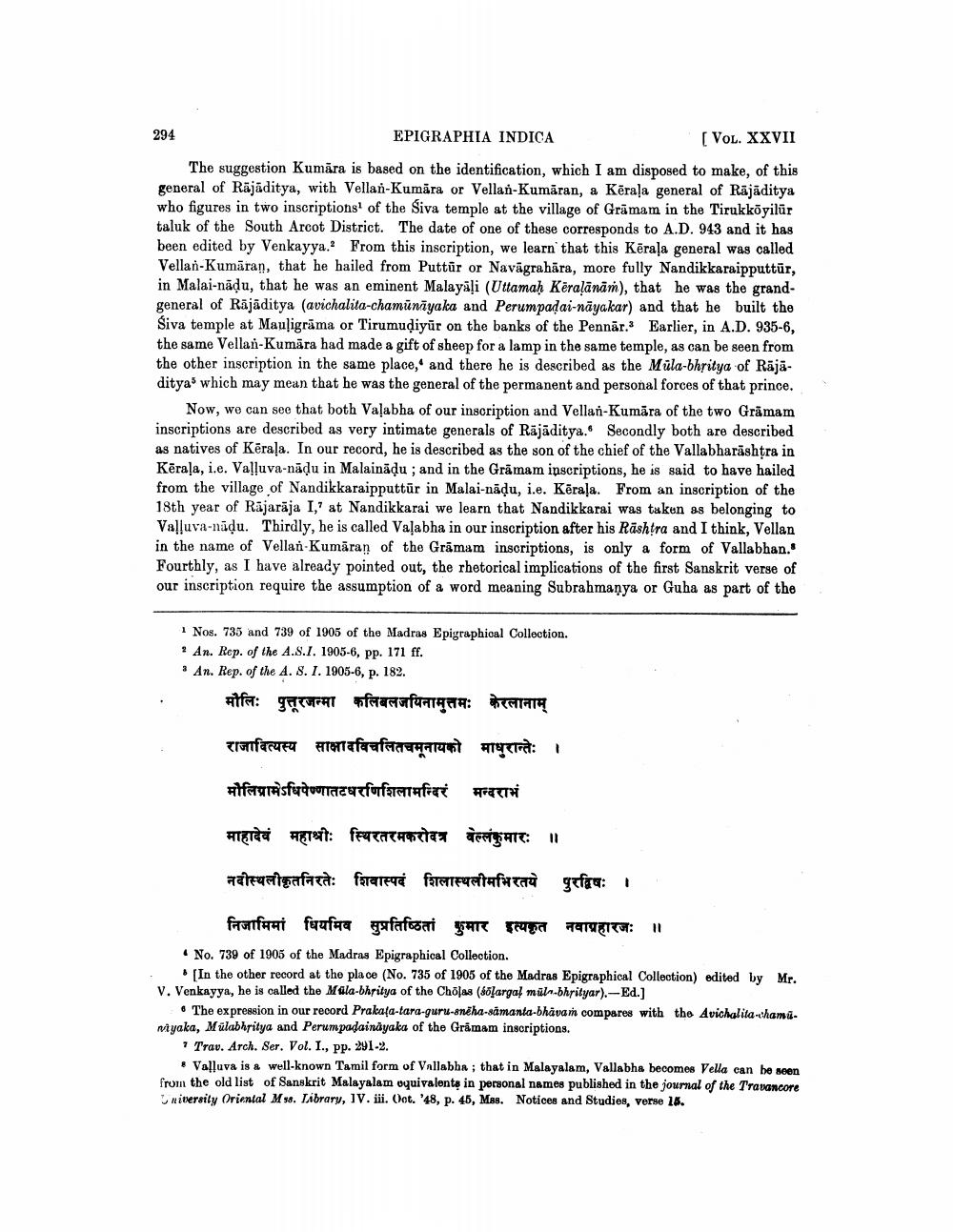________________
EPIGRAPHIA INDICA
[VOL. XXVII
The suggestion Kumara is based on the identification, which I am disposed to make, of this general of Räjäditya, with Vellan-Kumāra or Vellan-Kumaran, a Kerala general of Räjäditya who figures in two inscriptions' of the Siva temple at the village of Gramam in the Tirukkōyilür taluk of the South Arcot District. The date of one of these corresponds to A.D. 943 and it has been edited by Venkayya. From this inscription, we learn that this Kerala general was called Vellan-Kumaran, that he hailed from Puttur or Navagrahara, more fully Nandikkaraipputtür, in Malai-naḍu, that he was an eminent Malayali (Uttamaḥ Keralānām), that he was the grandgeneral of Räjäditya (avichalita-chamunayaka and Perumpaḍai-nayakar) and that he built the Šiva temple at Mauligrama or Tirumuḍiyur on the banks of the Pennar. Earlier, in A.D. 935-6, the same Vellan-Kumāra had made a gift of sheep for a lamp in the same temple, as can be seen from the other inscription in the same place, and there he is described as the Mula-bhritya of Räjäditya which may mean that he was the general of the permanent and personal forces of that prince.
294
Now, we can see that both Valabha of our inscription and Vellan-Kumara of the two Grāmam inscriptions are described as very intimate generals of Räjäditya. Secondly both are described as natives of Kerala. In our record, he is described as the son of the chief of the Vallabharashtra in Kēraļa, i.e. Valluva-nāḍu in Malaināḍu; and in the Gramam inscriptions, he is said to have hailed from the village of Nandikkaraipputtur in Malai-naḍu, i.e. Kerala. From an inscription of the 18th year of Rajaraja I,' at Nandikkarai we learn that Nandikkarai was taken as belonging to Valluva-nadu. Thirdly, he is called Valabha in our inscription after his Rashtra and I think, Vellan in the name of Vellan-Kumaran of the Gramam inscriptions, is only a form of Vallabhan." Fourthly, as I have already pointed out, the rhetorical implications of the first Sanskrit verse of our inscription require the assumption of a word meaning Subrahmanya or Guha as part of the
1 Nos. 735 and 739 of 1905 of the Madras Epigraphical Collection.
2 An. Rep. of the A.S.I. 1905-6, pp. 171 ff.
An. Rep. of the A. S. I. 1905-6, p. 182.
मौलि: पुत्तूरजन्मा कलिबलजयिनामुत्तमः केरलानाम् राजावित्यस्य साक्षादविचलितचमूनायको माधुरान्तेः । #frismawrfufumref मन्दराभ
माहादेवं महाश्रीः स्थिरतरमकरोत्र बोलंकुमारः ॥
नदीस्वीकृतनिरते: शिवास्पदं शिलास्पलीमभिरतये पुरद्विषः ।
निजामिम मियमिव सुप्रतिष्ठितां कुमार इत्यकृत नयाहारक: 11
No. 739 of 1905 of the Madras Epigraphical Collection.
[In the other record at the place (No. 735 of 1905 of the Madras Epigraphical Collection) edited by Mr. V. Venkayya, he is called the Müla-bhritya of the Cholas (solargal mula-bhrityar).-Ed.]
The expression in our record Prakata-tara-guru-sněha-samanta-bhavam compares with the Avichalita-chamuniyaka, Mülabhritya and Perumpadainayaka of the Gramam inscriptions.
7 Trav. Arch. Ser. Vol. I., pp. 291-2.
Valluva is a well-known Tamil form of Vallabha; that in Malayalam, Vallabha becomes Vella can be seen from the old list of Sanskrit Malayalam equivalents in personal names published in the journal of the Travancore University Oriental Mss. Library, IV. iii. Oct. 48, p. 45, Mss. Notices and Studies, verse 15.




